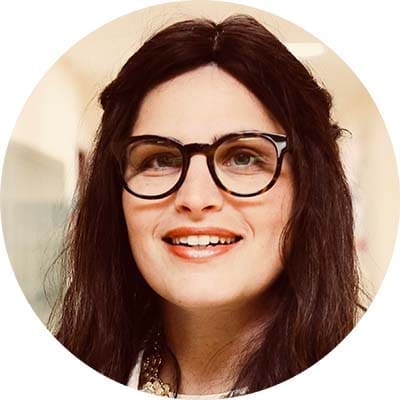It was the model of a truck that made us realize that the project was a success. Students were challenged to create artifacts for a museum as the culmination of our unit focused on Megillah, discussing objects that serve holy things or God’s name. Once an item functions to serve something holy, such as a Torah, that item takes on special status and needs to be treated differently. What better modern, practical implication could there be of these laws than a truck carrying Torah scrolls?
Design Thinking is a problem-solving approach that includes iterative thinking—planning, experimenting, learning from failure, and restarting again. Given that Design Thinking is an approach used in other areas of our school, specifically in science, we thought that it would be enriching for our students to try this type of learning in Jewish studies as well to make the text-based study come alive. A central tenet in the study of halakha is that it is dynamic and adapts to every time period. Furthermore, the dialogue in the Talmud, which includes the use of extreme cases to establish principles that can be applied to other cases, followed by refutations of the Rabbis, is a form of failing forward. The tradition of Jewish law is the result of debate, failing forward, and learning. Design Thinking, with its emphasis on experimentation and failing forward, is a model that is perfectly suited for student learning and understanding of halakha. It supports the exploration of the banter in the Talmud, which is what draws adolescent students into the text and helps students to understand that the evolution of Torah law is the product of many views and the debate surrounding them.
As we imagined integrating Design Thinking into Jewish studies it became clear that we should try to include the use of our makerspace—an engineering lab for children including tools (hammers, glue guns, a drill, paint, computers, and craft materials) and endless supplies that make any person of any age want to create. The space has been used for lessons about how to make the speediest car or what materials impact the foundation of a structure but had not yet been used for Jewish studies. This was our opportunity to integrate cutting-edge pedagogy into our Jewish studies program to energize and excite the students.
Here is the text we were studying:
The Sages taught in a baraita: Articles used in the performance of a mitzvah may be thrown out after use. However, articles associated with the sanctity of God’s name, i.e., articles on which God’s name is written, and articles that serve an article that has God’s name written on it, even after they are no longer used, must be interred in a respectful manner. (Translation from Sefaria.)
Our challenge was to cultivate within the class a comfort for failing forward. Students needed to use the Design Thinking approach to create a model and either succeed or fail forward in its creation.
The assignment was to create a museum with artifacts representing various holy items and museum plaques detailing the Jewish legal implications for the items. In the case of the truck: if it does regularly carry Torah scrolls, does its status change from one which is used in the performance of a mitzvah to that of a tashmish kedusha, an article associated with the sanctity of God’s name?
We needed to consider identifying elements of what we learned in the text. What is the length of time needed to make something a tashmish kedusha? What was the intention of the truck—is it only to transport the Torah or does it honor it in some way? And then we thought about another item, a student backpack holding Jewish books (siddur, Humash, etc.): how can it be crafted in a way that protects those sacred books? Some creative students figured out how to totally secure a cover on the table used for Torah reading, so that the table never comes into direct contact with the Torah, preventing it from being classified as a tashmish kedusha.
Since this was our first attempt at a project like this, every step of the way we needed to fail forward ourselves. For instance, how should the models be evaluated? A rubric, of course. Who should create the rubric? We decided that it should be the students, since a critical element of Design Thinking is the ability to self-evaluate and be an active, rather than passive learner and evaluator. This represented a dramatic shift from traditional modes of text study in which students are passive (particularly when studying Talmud with its Aramaic language, unique terminology, and difficult to read sentence structure, in which students are heavily dependent on their teachers) rather than active learners.
Another challenge was that our makerspace needed to be retooled from one which primarily served younger children to one whose materials, tools, and space could be adjusted for older students. For example, when reviewing the students’ prototypes, we realized that the middle school students we were working with could benefit from having sewing machines and heavier tools and should be given even more freedom in the actual space than younger children. A microgrant through the Jewish Education Project was extremely helpful in moving this retooling forward. Similarly, the guidelines for use of the makerspace were adapted through group meetings with the class, and when they needed to be adjusted, we failed forward, using student-generated ideas to recalibrate the rules.
The project demanded that teachers begin to think differently about their work as well. Teamwork, co-teaching, and failing forward replaced siloed teaching. The director of educational and professional initiatives, including the makerspace, teamed up with the eighth-grade teacher for girls’ Gemara, each bringing different strengths to the team and complementing the other. Both ended up enriched from the experience.
Aside from making the concepts tangible for the students, the project enabled them to grow from the learning process. As the students adjusted their projects they were able to see how the varying halakhic ideas were relevant and played themselves out. The process of failing forward and adjusting their plans dynamically shifted their lenses to see mistakes as part of the learning process, especially as they understood that we expected changes to happen between their prototype drawing and their actual final product.
The teachers were forced outside of their comfort zones and extended the way that they think about instruction. Like the students, they too learned to plan dynamically, reflecting after each day and adjusting the upcoming lesson based on where they left off the day before. The project inspired regular class meetings to hear from the students and generated a sense of partnership with the students which was profoundly empowering for both students and teachers.
The success of this project is driving our school to explore additional use of the makerspace in other Jewish studies classes. The growth for the students and the teachers has been an experience we want to replicate as we energize ourselves as teachers and our students as learners.

Pesha Kletenik is the principal of Yeshiva Har Torah in Little Neck, Queens. Dr. Kletenik holds a Doctorate in Education from Hofstra University, with a specialization in Human Development and Educational Psychology. She is currently pursuing a Master’s degree at the Emil A. and Jenny Fish Center for Holocaust and Genocide Studies at Yeshiva University.

Karen Simon is the Director of Curricular and Professional Initiatives at Yeshiva Har Torah in Little Neck, Queens. Mrs. Simon earned her Master’s Degree in Education at Hofstra University. She is a teacher mentor in the Jewish New Teacher Project. Mrs. Simon has served as a team leader of YHT teachers to coordinate and develop curriculum and hone teaching techniques.
Reach 10,000 Jewish educational professionals. Advertise in the upcoming issue of Jewish Educational Leadership.





